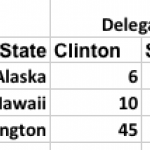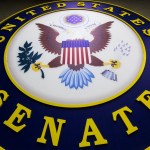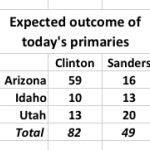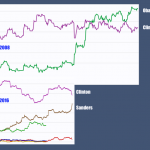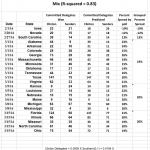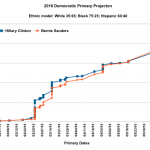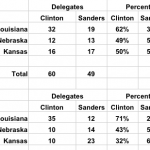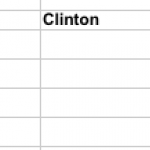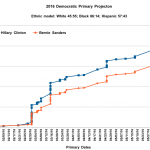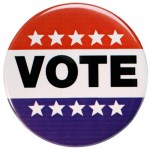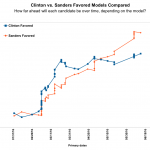Election 2016
This discussion is a little ambiguous about "winning the nomination" vs. "winning the general election" but it is fun to see Keith Olbermann again. He states here that he is coming out of retirement.
Olbermann correctly points out something I think a lot of people don't know or understand. A political party is an independent private entity (though there are some regulations and they must operate within the law). One of the first things they will do at the convention is to vote on rules. At that point, they can make any rule they want, pretty much. The rule could be "no nomination for…
Everybody knows about the little bird, a House Finch, I believe, that flew up to Bernie Sanders at a recent event.
However, the YouTube Video that is circulating has lousy sound quality and cuts off some of the context.
So, here I give you a better version.
Today and tomorrow we have the Alaska, Hawaii, and Washington Democratic primaries.
According to the model I developed prior to the last primary, which predicts future primaries using information about primaries to date (which I've not updated from last Tuesday), Sanders will win all three primaries. That model suggests that the delegate spread by the end of the day will look like this:
However, I also developed an alternate model which assumes that Sanders' over performance (in relation to the afore mentioned model) requires an adjustment. That alternative model suggests that this will…
I'm trying to figure out how many Senate seats, and which ones, will switch from Republican to Democratic in November 2016.
At present, 54 Senator caucus with the Republicans, and 46 caucus with the Democrats (two of those are Independant).
We should be shooting for a good majority of 61, just to be safe. That means fifteen Republicans have to go, to result in a 39 to 61 mix. To get a simple majority, only five Republicans have to be replaced, to produce a 49 to 51 mix. So, we should be working for replacing fifteen but hoping to replace at least five.
A perusal of The Internet…
Bernie Sanders has either stated or implied two features that make up his strategy to win the Democratic nomination to be the party's candidate for President this November.
Implied, sort of stated: Convince so-called "Superdelegates" (properly called "uncommitted delegates") in states where he has won to vote for him, even if he is in second. That is a good idea, and if the two candidates are close, it could happen. However, when I run the numbers, giving Bernie "his" uncommitted delegates and Hillary "her" uncommitted delegates, it is pretty much a wash. The uncommitted delegates are not…
This post was written in two parts, pre-primary and post-primary. To see the result and a discussion of what they mean, skip down to the last part of the post, where I'll discuss why Tuesday's results may mean that Sanders could win the primary.
Pre-Primary
As already discussed, Clinton is likely to win the Democratic nomination. Sanders is too far behind to catch up without extraordinary results, as outlined here. However, it is also true that Sanders is likely to win a majority of contests from here on out, while at the same time, Clinton is likely to win many (if not most?) of the actual…
UPDATED: The graphic above is updated from the original post to show the delegate counts this year through the New York Primary. I've also added the projected delegate counts based on my model, as dashed lines, through the end of the primary.
A while back I posted an item comparing the current, 2016, Democratic primary process with the 2008 primary that mainly involved Hillary Clinton and Barack Obama. I posted the following graphic comparing the Real Clear Politics polling data summary over the course of the primary cycle. That was at a point in time when Bernie Sanders was gaining on…
Almost exactly 50% of the votes have been cast in the Democratic Party primary and caucus process. I've been updating a model to predict primary and caucus results all along, and the model has done fairly well. The most recent update, however, was a bit off. That update involved separating states into two groups, southern vs northern, then calculating different sets of likely voting patterns by ethnicity for those two groups, and integrating that with estimates of ethnic distribution ("white, black, hispanic") among Democratic voters by state.
What I did not do in those models was to…
I'm starting this post before any primary results are in, and I'll add the outcome of the primaries below, where I will also compare the results to my predictions and discuss what I think this means for the overall process of the Democratic primaries. But first, I wanted to get some thoughts down to contextualize my thinking on this. I'll publish this post now, at mid-day Tuesday, so look for an update late Tuesday night, or early Wednesday.
I like Hillary Clinton, and I often think that her presidency would be better than a Sanders presidency, with an inaugural in 2017. This is based on…
Most polls and FiveThirtyEight predict a Clinton blow-out on Tuesday, with her winning all five states, in some cases by a large margin. My model, however, predicts that each candidate will win a subset of these states, but with Clinton still win the day.
I’ve been working on a model to predict primary outcomes for the Democratic selection process, and generally, the model has proved very effective. After each set of primaries I’ve adjusted the model to try to do a better job of predicting the upcoming contests. The most important adjustment is the one that affects the current model.
The…
I have been presenting various versions of a model to predict the outcome of upcoming Democratic primaries. The earlier version of the model worked like this: Make some assumptions about the ratio of voting preference (for Sanders vs. Clinton) among the different major ethnic groups, and using the known distribution of said ethnic groups, predict the future.
I started out with the assumption that among whites, the ratio would be 50:50, based on one datum, the outcome from Iowa, which is essentially a white state. I used a bias for African Americans and Hispanic voters favoring Clinton.…
I developed a predictive model for the Democratic primaries that was designed to have the following features:
1) It does not rely on polling;
2) It does use exit polling and other information to set certain parameters;
3) It mainly uses prior primary or caucus results to predict the future, and thus assumes that the status quo is the best indicator.
4) It calculates likely voting patterns based on ethnicity (White, African American, Hispanic), and using likely Democratic party distribution among these groups to predict each contest's outcome.
That method outperformed most other predictions…
Yesterday, the Democrats held three contests, in Louisiana, Nebraska and Kansas. I had predicted a Sanders win in Nebraska and Kansas, and a Clinton win in Louisiana, using my ever-evolving ethnicity-based projection model. Those predictions came to fruition. Like this:
Predicted on top, Actual on bottom.
Clinton did a bit better than projected in Louisiana, and Sanders did a bit better in Nebraska, but much better in Kansas than predicted.
I had projected the final delegate count to be 60:49 (Clinton:Sanders) for that day, and it turned out to be 55:49 (Clinton:Sanders). The difference…
This weekend there are Democratic Party primaries or caucuses in Kansas, Louisiana, Nebraska, Maine and Puerto Rico. The model I developed for predicting primary and caucus outcomes indicates the following results as most likely:
Sanders is losing the primaries, so far, and Clinton is on the path to victory. However, Sanders has a fair amount of time to catch up. Perhaps he just needs his strategy to take hold. The idea was to have a revolution, which in this case, means a lot of people show up. A lot of people did show up, but not enough. Sanders needs to get the rest of them to show up…
A lot of people don't like the Minnesota presidential "caucus" (which is really a somewhat dysfunctional primary, not a caucus). Here is a discussion of that problem and suggestions as to how to fix it, over at Minnesota Progressive Project where I sometimes blog (but not enough, I should do more, it is a great place).
As you know, I developed a simple model for projecting future primary outcomes in the Democratic party. This model is based on the ethnic mix in each state, among Democratic Party voters. The model attributes a likely voting choice to theoretical primary goers or causers based on previous behavior by ethnicity. Originally I made two models, one using numbers that the Clinton campaign was banking on, and one using numbers that the Sanders campaign was banking on.
The results of the Super Tuesday primaries demonstrated that the Sanders-favoring model does not predict primary outcomes.…
Put your stuff in the comments!
Also being discussed on my Facebook page.
Here's my predictions, by the way:
Tuesday evening, 10:45 central:
They even have a short list of candidates. Unfortunately, the only available copy of the secret internal report on running a third party candidate has the list blacked out (see above).
According to Scott Bland at Politico:
Conservative donors have engaged a major GOP consulting firm in Florida to research the feasibility of mounting a late, independent run for president amid growing fears that Donald Trump could win the Republican nomination.
...
“All this research has to happen before March 16, when inevitably Trump is the nominee, so that we have a plan in place," a source familiar with…
You may be asking yourself the same question, especially if, like me, you vote on Tuesday, March 1st.
For some of us, a related question is which of the two is likely to win the nomination.
If one of the two is highly likely to win the nomination, then it may be smart to vote for that candidate in order to add to the momentum effect and, frankly, to end the internecine fighting and eating of young within the party sooner. If, however, one of the two is only somewhat likely to win the nomination, and your preference is for the one slightly more likely to lose, then you better vote for the…
I recently developed a model of how the primary race will play out between Democratic presidential hopefuls Hillary Clinton and Bernie Sanders.
That model made certain assumptions, and allowed me to produce two projections (well, many, but I picked two) depending on how each candidate actually fairs with different ethnic groups (White, Back, Hispanic, since those are the groupings typically used).
The two different versions of this model were designed to favor each candidate differently. The Clinton-favored model started with the basic assumption that among white Democratic Party voters,…

